
Tallinn Airport or Lennart Meri Tallinn Airport is the largest airport in Estonia, which serves as a hub for the national airline Nordica, as well as the secondary hub for AirBaltic, cargo airline Airest and LOT Polish Airlines. It was also the home base of the now defunct national airline Estonian Air. Tallinn Airport is open to both domestic and international flights. It is located 2.7 nautical miles southeast of the centre of Tallinn on the eastern shore of Lake Ülemiste. It was formerly known as Ülemiste Airport.

Speed limits on road traffic, as used in most countries, set the legal maximum speed at which vehicles may travel on a given stretch of road. Speed limits are generally indicated on a traffic sign reflecting the maximum permitted speed - expressed as kilometres per hour (km/h) and/or miles per hour (mph). Speed limits are commonly set by the legislative bodies of national or provincial governments and enforced by national or regional police and judicial authorities. Speed limits may also be variable, or in some places nonexistent, such as on most of the Autobahnen in Germany.
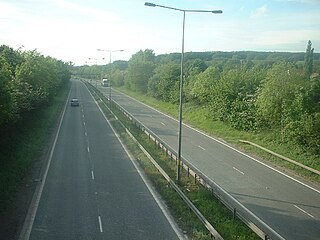
A dual carriageway (BrE) or a divided highway (AmE) is a class of highway with carriageways for traffic travelling in opposite directions separated by a central reservation (BrE) or median (AmE). Roads with two or more carriageways which are designed to higher standards with controlled access are generally classed as motorways, freeways, etc., rather than dual carriageways.
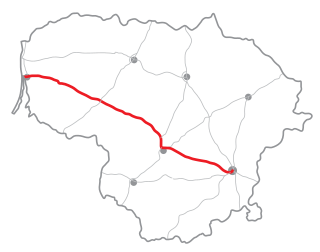
The A1 highway is a highway in Lithuania, connecting the three largest Lithuanian cities: Vilnius, Kaunas, and Klaipėda. The highway is 311.4 kilometres (193.5 mi) long, making it the longest highway route in Lithuania.

The road hierarchy categorizes roads according to their functions and capacities. While sources differ on the exact nomenclature, the basic hierarchy comprises freeways, arterials, collectors, and local roads. Generally, the functional hierarchy can more or less correspond to the hierarchy of roads by their owner or administrator.

A limited-access road, known by various terms worldwide, including limited-access highway, dual-carriageway, expressway, limited-access freeway, and partial controlled access highway, is a highway or arterial road for high-speed traffic which has many or most characteristics of a controlled-access highway, including limited or no access to adjacent property, some degree of separation of opposing traffic flow, use of grade separated interchanges to some extent, prohibition of slow modes of transport, such as bicycles, (draught) horses, or self-propelled agricultural machines; and very few or no intersecting cross-streets or level crossings. The degree of isolation from local traffic allowed varies between countries and regions. The precise definition of these terms varies by jurisdiction.
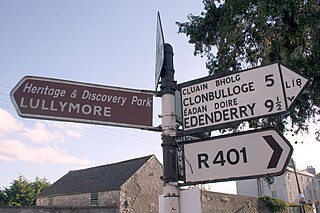
Road signs in Ireland do not differ greatly from those used elsewhere in Europe, but there are some differences between those used in the Republic of Ireland and those used in Northern Ireland, including different systems of units used in each jurisdiction.

2+1 road is a specific category of three-lane road, consisting of two lanes in one direction and one lane in the other, alternating every few kilometres, and usually separated with a steel cable barrier. The second lane allows faster-moving traffic to overtake slower vehicles at regular intervals. Traditional roads of at least 10 metres (33 ft) width can be converted to 2+1 roads and reach near-motorway safety levels at a much lower cost than an actual conversion to motorway or dual carriageway.

The rail transport system in Estonia consists of about 1,200 kilometres (750 mi) of railway lines, of which 900 kilometres (560 mi) are currently in public use. The infrastructure of the railway network is mostly owned by the state and is regulated and surveyed by the Estonian Technical Surveillance Authority.
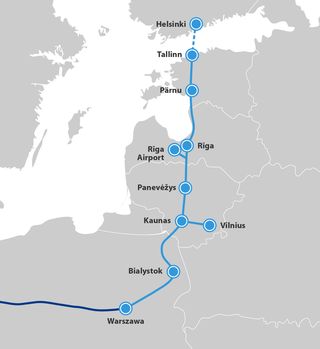
Rail Baltica is a greenfield rail transport infrastructure project with a goal to integrate the Baltic states in the European rail network. Its purpose is to provide passenger and freight service between participating countries and improve rail connections between Central and Northern Europe, specifically the area in the Southeast of the Baltic sea. Furthermore, it is intended to be a catalyst for building the economic corridor in Northeastern Europe. The project envisages a continuous rail link from Tallinn (Estonia) to Warsaw (Poland). It consists of links via Riga (Latvia), Kaunas and Vilnius (Lithuania) whose total length in the Baltic States is 870 kilometres (540 mi), with 213 kilometres (132 mi) in Estonia, 265 kilometres (165 mi) in Latvia, and 392 kilometres (244 mi) in Lithuania. Rail Baltica is one of the priority projects of the European Union. It is part of the North Sea–Baltic Corridor of the Trans-European Transport Networks (TEN-T).

A speed limit is the limit of speed allowed by law for road vehicles, usually the maximum speed allowed. Occasionally, there is a minimum speed limit. Advisory speed limits also exist, which are recommended but not mandatory speeds. Speed limits are commonly set by the legislative bodies of national or local governments.

The A1 highway (Riga - Border of Estonia ), also known as the Tallinn highway is a national road in Latvia, which connects the Riga bypass with the Estonian border at Ainaži. The highway continues in Estonia as highway 4 until Tallinn. A1 is fully covered in asphalt, and its length in Latvia is 101,7 km. The highway is part of European route E67 and, starting from Lilaste until the Estonian border, does not move further than 6 km from the coast of the Baltic sea.

Road speed limits in the United Kingdom are used to define the maximum legal speed for vehicles using public roads in the UK. Speed limits are one of the measures available to attempt to control traffic speeds, reduce negative environmental effects of traffic, increase fuel use efficiency and satisfy local community wishes. The speed limit in each location is indicated on a nearby traffic sign or by the presence of street lighting. Signs show speed limits in miles per hour (mph) or the national speed limit (NSL) sign may be used.

Speed limits in Finland are generally:

The speed limit for cars in Ukraine are as follows:

The Strade Statali, abbreviated SS, is the Italian national network of state highways. The total length for the network is about 18,000 km (11,000 mi).

Põhimaantee 1 is a 212-kilometre-long west-east national main road in Estonia. The road is part of the European route E20. The highway starts in Tallinn. From there the main cities passed are Maardu, Rakvere, Kohtla-Järve, Jõhvi and Sillamäe. The highway ends in Narva on Friendship Bridge, with a border crossing to Russia over the Narva river.

Põhimaantee nr 2 is a 280-kilometre-long north-south national main road in Estonia. The route follows the same path as the European route E263. The highway starts in Tallinn. From there the main cities passed are Kose, Paide, Põltsamaa, Tartu and Võru. The highway ends in Lüta on the intersection with the T7.

Põhimaantee 4 is a 192-kilometre-long north-south national main road in Estonia. The route follows the same path as the European route E67, also known as the Via Baltica. The highway starts in Tallinn. From there the main cities passed are Saue, Märjamaa and Pärnu. The highway ends in Ikla at the Latvian border.
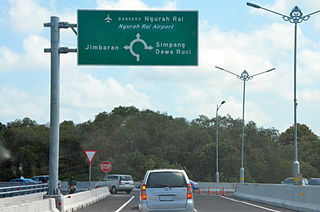
Road signs in Indonesia are standardized road signs similar to those used in other nations but with certain distinctions. As a former Dutch colony, until the 1970s road signs in Indonesia closely followed The Netherlands rules on road signs. Nowadays, Indonesian road sign design are a mix of European, US MUTCD, Australia, New Zealand and Japanese road sign features. According to the 2014 Minister of Transport's Regulation No. 13 concerning Traffic Signs, the official typeface for road signs in Indonesia is Clearview. Indonesia formerly used FHWA Series fonts as the designated typeface though the rules are not being implemented properly.




















